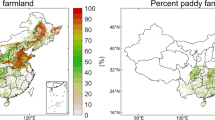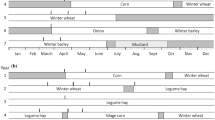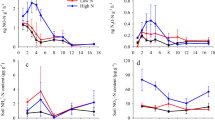Abstract
The background nitrous oxide (N2O) emission (BNE) from agricultural soils originates from microbial nitrification and denitrification processes of soil nitrogen supplies, excluding emissions from nitrogen fertilizers applied in the current year. It is of great necessity to quantify BNE accurately at various spatial scales since BNE contributes considerably to the overall N2O emissions from croplands. Annual BNE rates across various soil/climate regions and major cropping systems of China were determined by network observations during 2002–2006 using the static chamber technique. The observations show BNE rates ranging from 0.1 to 3.67 kg N ha−1 year−1, with a mean of 1.35 kg N ha−1 year−1. Empirical functions are derived for cultivated mineral soils and describe the dependences of annual BNE rates upon soil total nitrogen (TN) content, soil organic carbon (SOC) content, bulk density (BD) and clay fraction (CF), separately or collectively. These empirical functions provide simple approaches to scale up estimated national/regional BNE inventories using available database of soil properties surveys and cropland area statistics. The national BNE of China is estimated to be 0.114–0.184 Tg (1 Tg = 1012 g) N year−1 in 2000, with the range being due to the use of different approaches. However, the available observations of annual BNE rates do not cover the entire range of soil properties on a national scale. Further work is needed to verify the empirical models for a complete range of soil types. In addition, a predictive empirical relationship between annual BNE rates and TN or SOC is established for cultivated mineral soil at the global scale. However, the empirical models could not accurately predict the BNE rates of cultivated organic soils. Further studies are required to understand the regulatory effects of soil properties on annual BNE rates of cultivated organic soils.



Similar content being viewed by others
References
Borken W, Brumme R (1997) Liming practice in temperate forest ecosystems and the effects on CO2, N2O, and CH4 fluxes. Soil Use Manage 13:251–257
Bouwman AF (1996) Direct emissions of nitrous oxide from agricultural soils. Nutr Cycl Agroecosys 46:53–70
Bouwman AF, Boumans LJM, Batjes NH (2002) Emissions of N2O and NO from fertilized fields: summary of available measurement data. Global Biogeochem Cycles 16:1080–1088
Bronson KF, Mosier AR (1993) Nitrous oxide emissions and methane consumption in wheat and corn cropped systems. In: Harper LA (ed) Agricultural ecosystem effects on trace gases and global climate change, vol 55. American Society of Agronomy Special Publication, Madison, pp 133–144
Brumme R, Beese F (1992) Effects on liming and nitrogen-fertilization on emissions of CO2 and N2O from a temperate forest. J Geophys Res 97:12851–12858
Cates RL, Keeney DR (1987) Nitrous oxide production throughout the year from fertilized and manured maize fields. J Environ Qual 16:443–447
Davidson EA (1991) Fluxes of nitrous oxide and nitric oxide from terrestrial ecosystems. In: Rogers JE, Whitman WB (eds) Microbial production and consumption of greenhouse gases: methane, nitrogen oxides, and halomethanes. American Society for Microbiology, Washington, pp 219–235
Davidson EA (1993) Soil water content and the ratio of nitrous oxide to nitric oxide emitted from soils. In: Oremland RS (ed) Biogeochemistry of global change: radioactively active trace gases. Chapman and Hall, New York, pp 369–386
Ding W, Meng L, Cai Z, Han F (2007) Effects of long-term amendment of organic manure and nitrogen fertilizer on nitrous oxide emission in a sandy loam soil. J Environ Sci 19:185–193
Dong Y, Scharffe D, Qi Y, Peng G (2001) Nitrous oxide emissions from cultivated soils in the North China Plain. Tellus 53:1–9
Duxbury JM, Bouldin DR, Terry RE, Tate RL III (1982) Emissions of nitrous oxide from soils. Nature 298:462–464
Egginton GM, Smith KA (1986) Losses of nitrogen by denitrification from a grassland soil fertilized with cattle slurry and calcium nitrate. J Soil Sci 37:69–80
Gödde M, Conrad R (2000) Influence of soil properties on the turnover of nitric oxide and nitrous oxide by nitrification and denitrification at constant temperature and moisture. Biol Fertil Soils 32:120–128
Hao X, Chang C, Carefoot JM, Janzen HH, Ellert BH (2001) Nitrous oxide emissions from an irrigated soil as affected by fertilizer and straw managements. Nutr Cycl Agroecosys 60:1–8
Henault C, Devis X, Lucas JL, Germon JC (1998) Influence of different agricultural practices (type of crop, form of N-fertilizer) on soil nitrous oxide emissions. Biol Fertil Soils 27:299–306
Huang G, Chen G, Zhang Z, Wu J, Huang B, Van Cleemput O (1998) A study on N2O emission from maize fields and its mitigation measures (in Chinese). Acta Environ Sci 18:344–349
Huang Y, Jiao Y, Zong L, Wang Y, Sass RL (2002) Nitrous oxide emissions from the wheat-growing season in eighteen Chinese paddy soils: an outdoor pot experiment. Biol Fertil Soils 36:411–417
Intergovernmental Panel on Climate Change (IPCC) (1997) Guidelines for national greenhouse gas inventories: greenhouse gas inventory reference manual. Revised 1996. IPCC/OECD/IGES, Bracknell
Intergovernmental Panel on Climate Change (IPCC) (2000) Good practice guidance, uncertainty management in national greenhouse gas inventories, IPCC/IGES, Kanagawa
Intergovernmental Panel on Climate Change (IPCC) (2001) Climate change 2001-synthesis reports: third assessment report of the Intergovernmental Panel on Climate Change. Cambridge University Press, New York
International Union of Soil Sciences (IUSS) Working Group WRB (2006) World references base for soil resources 2006, 2nd edn. World soil resources reports no. 103. Food and Agriculture Organization of the United Nations (FAO), Rome. http://www.fao.org/ag/Agl/agll/wrb/doc/wrb2006final.pdf
Ju X, Liu X, Zhang F, Roelcke M (2003) Nitrogen fertilization, soil nitrate accumulation, and policy recommendations in several agricultural regions of China. Ambio 33:300–305
Jungkunst HF, Freibauer A, Neufeldt H, Bareth G (2006) Nitrous oxide emissions from agricultural land use in Germany—a synthesis of available annual field data. J Plant Nutr Soil Sci 169:341–351
Kroeze C, Mosier A, Bouwman L (1999) Closing the global N2O budget: a retrospective analysis 1500–1994. Global Biogeochem Cycles 13:1–8
Li C, Zhuang Y, Cao M, Crilll P, Dai Z, Frolking S, Moore B, Salas W, Song W, Wang X (2001) Comparing a national inventory of N2O emissions from arable lands in China developed with a process-based agro-ecosystem model to the IPCC methodology. Nutr Cycl Agroecosys 60:159–170
Meng L, Ding W, Cai Z (2005) Long-term application of organic manure and nitrogen fertilizer on N2O emissions, soil quality and crop production in a sandy loam soil. Soil Biol Biochem 37:2037–2045
Mosier AR (1994) Nitrous oxide emissions from agricultural soils. Fertil Res 37:191–200
Mosier A, Kroeze C (1998) A new approach to estimate emissions of nitrous oxide from agriculture and its implications for the global N2O budget. IGBP Newslett 34:8–13
Nägele W, Conrad R (1990) Influence of pH on the release of NO and N2O from fertilized and unfertilized soil. Biol Fertil Soils 10:139–144
Nevison CD, Holland EA (1997) A reexamination of the impact of anthropogenically fixed nitrogen on atmospheric N2O and the stratospheric O3 layer. J Geophys Res 102:25519–25536
Nödar R, Acea MJ, Carballas T (1992) Microbial response to Ca(OH)2 treatments in a forest soil. FEMS Microbiol Ecol 86:213–219
Papen H, Hellmann B, Papke H, Rennenberg H (1993) Emission of N-oxides from acid irrigated and limed soils of a coniferous forest in Bavaria. In: Oremland RS (ed) Biogeochemistry of global change: radioactively active trace gases. Chapman and Hall, New York, pp 245–260
Ryden JC (1983) Denitrification loss from a grassland soil in the field receiving different rates of nitrogen as ammonium nitrate. J Soil Sci 34:355–365
Terry RE, Tate RL III, Duxbury JM (1981) Nitrous oxide emissions from drained, cultivated organic soils in South Florida. J Air Pollut Control Assoc 31:1173–1176
Velthof GL, Oenema O, Postma R, Van Beusichem ML (1996) Effects of type and amount of applied nitrogen fertilizer on nitrous oxide fluxes from intensively managed grassland. Nutr Cycl Agroecosys 46:257–267
Wang YS, Wang YH (2003) Quick measurement of CH4, CO2 and N2O emissions from a short-plant ecosystem. Adv Atmos Sci 20:842–844
Wang S, Song W, Su W (1994) N2O emission from winter wheat fields (in Chinese). Agro Environ Prot 13:210–212
Webster CP, Dowdell RJ (1982) Nitrous oxide emission from permanent grass swards. J Sci Food Agric 33:227–230
Weitz AM, Linder E, Frolking S, Crill PM, Keller M (2001) N2O emissions from humid tropical agricultural soils: effects of soil moisture, texture and nitrogen availability. Soil Biol Biochem 33:1077–1093
Williams EJ, Hutchinson GL, Fehsenfeld FC (1992) NO x and N2O emissions from soil. Global Biogeochem Cycles 6:351–388
Xing GX (1998) N2O emission from cropland in China. Nutr Cycl Agroecosys 52:249–254
Xing GX, Zhu ZL (1997) Preliminary studies on N2O emission fluxes from upland soils and paddy soils in China. Nutr Cycl Agroecosys 49:17–22
Xiong Z, Xing G, Tsuruta H, Shen G, Shi S, Du L (2002) Measurement of nitrous oxide emissions from two rice-based cropping systems in China. Nutr Cycl Agroecosys 64:125–133
Xu H, Xing G, Cai Z, Tsoruta H (2000) Effect of soil texture on N2O emissions from winter wheat and cotton fields (in Chinese). Agro Environ Prot 19:1–3
Yan X, Akimoto H, Ohara T (2003) Estimation of nitrous oxide, nitric oxide and ammonia emissions from croplands in East, Southeast and South Asia. Glob Change Biol 9:1080–1096
Zeng J, Wang Z, Zhang Y, Song W, Wang S, Su W (1995) N2O flux from soil during wheat-maize rotation and estimation of total emission (in Chinese). Environ Sci 16:32–36
Zheng X, Wang M, Wang Y, Shen R, Gou J, Li J, Jin J, Li L (2000) Impacts of soil moisture on nitrous oxide emission from croplands: a case study on the rice-based agro-ecosystem in Southeast China. Chemos Glob Change Sci 2:207–224
Zheng X, Han S, Huang Y, Wang Y, Wang M (2004) Re-quantifying the emission factors based on field measurements and estimating the direct N2O emission from Chinese cropland. Glob Biogeochem Cycles 18:GB2018. doi: 10.1029/2003GB002167
Zheng X, Zhou Z, Wang YS, Zhu J, Wang YL, Yue J, Shi Y, Kobayashi K, Inubushi K, Huang Y, Han S, Xu Z, Xie B, Butterbach-Bahl K, Yang L (2006) Nitrogen-regulated effects of free-air CO2 enrichment on methane emissions from paddy rice fields. Glob Change Biol 12:1717–1732
Zou J, Huang Y, Lu Y, Zheng X, Wang Y (2005) Direct emission factor for N2O from rice-winter wheat rotation systems in southeast China. Atmos Environ 39:4755–4765
Acknowledgments
This study was jointly funded by grants from the National Natural Science Foundation of China (40331014, 40425010), CAS (KZCX3-SW-440, KZCX2-YW-204) and the European Union (NitroEurope IP 017841). We thank Prof. Dr Y. Wang, Mr G. Liu, Dr W. Zhang and Prof. W. Zhang for their technical assistance. Thanks are also due to the staff and students from IAP, ISS, IMHE, IAE and NIGA of CAS for their contribution to field observations.
Author information
Authors and Affiliations
Corresponding author
Rights and permissions
About this article
Cite this article
Gu, J., Zheng, X., Wang, Y. et al. Regulatory effects of soil properties on background N2O emissions from agricultural soils in China. Plant Soil 295, 53–65 (2007). https://doi.org/10.1007/s11104-007-9260-2
Received:
Accepted:
Published:
Issue Date:
DOI: https://doi.org/10.1007/s11104-007-9260-2




